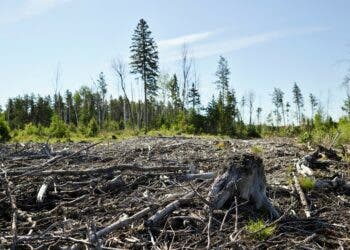
Trees have an important role to play in mitigating climate change thanks to their ability to absorb carbon from the atmosphere. During photosynthesis, this atmospheric carbon is used to generate new leaves, shoots, and roots.
You’d think that dense tropical forests, with their tall and lush canopies, are the most important terrestrial carbon sinks in the world — meaning they take in more carbon than they release. However, a landmark 2017 study found that tropical forests, from Congo to Indonesia, are actually net emitters of carbon. This release is through natural processes such as plant respiration, droughts, and wildfires, but also emissions from human activities like deforestation.
According to new research at the University of Birmingham, the largest terrestrial carbon sinks are actually young forests. This is rather counterintuitive but it makes sense once you hear the findings.
Young forests are defined as those comprised of trees younger than 140 years. These trees have typically reforested areas previously used for agriculture or cleared by fires. For instance, this includes forests in the USA’s eastern states, where settlers established farmlands but then abandoned them to move west in the 19th century. Other areas that have seen significant forest regrowth include boreal forests in Canada, Russia, and Europe, which have seen a lot of forest fires. Meanwhile, China’s $100-billion large-scale reforestation program is also making an important contribution to the carbon sink.
Drawing on data sets of forest ages, the researchers calculated the carbon balance between 2001 and 2010. According to the findings, areas of forest regrowth absorbed large amounts of carbon due to the fertilization of tree growth but also as a result of their young age, which accounted for 25% of carbon uptake. Interestingly, age-driven carbon uptake was most concentrated in the middle and high latitude, and not in the tropics.
“It’s important to get a clear sense of where and why this carbon uptake is happening, because this helps us to make targeted and informed decisions about forest management,” Dr Tom Pugh, of the Birmingham Institute of Forest Research, said in a statement.
One important takeaway is that this carbon uptake effect will be diminished as these forests age, meaning the carbon sink will disappear unless further reforestation occurs.
“The amount of CO2 that can be taken up by forests is a finite amount: ultimately reforestation programmes will only be effective if we simultaneously work to reduce our emissions,” explains Dr Pugh.






